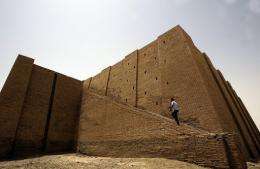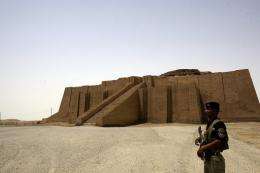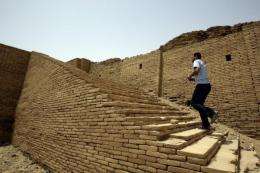Iraq's ancient Ur treasures 'in danger'

Standing before the imposing ziggurat which was once part of a temple complex at the Sumerian capital of Ur, Iraqi archaeologist Abdelamir Hamdani worried about the natural elements that are eating away at one of the wonders of Mesopotamia.
"Is there anybody thinking about preserving these monuments?" asked the doctoral student from New York's Stony Brook University who is one of the leaders of a nascent project to conserve the few unearthed remains of ancient Mesopotamia, one of the cradles of civilisation.
The buried treasures of Ur still beckon foreign archaeologists who have begun cautiously returning to Iraq, but experts like Hamdani say that preserving the sites is more urgent than digging for more.
Ur, the Biblical birthplace of Abraham, and which more than 4,000 years ago was the capital of a prosperous empire ruling over Mesopotamia, is believed to have so far relinquished only a fraction of its buried antiquities.
"Everybody likes the idea of excavations. People say we have to find ancient treasures," said Hamdani, who is involved in a joint project between Baghdad and a US non-governmental organisation to map and restore the site.
"There are treasures right under our feet," said Hamdani, referring to some of the riches that during the last large excavations decades ago were pulled out of the sand and carted off to museums in Iraq and abroad.
"But why cram these treasures into museums if the (unearthed) monuments are not preserved?" he asked rhetorically.
There have been no major excavations at Ur, which lies on the outskirts of the modern city of Nasiriyah about 300 kilometres (185 miles) south of Baghdad, since digs funded by the British Museum and the University of Pennsylvania in the 1920s and 1930s. The site has so far relinquished only about 10 percent of its riches, experts say.
British archaeologist Charles Leonard Woolley found some of the greatest treasures of antiquity at Ur, including a golden dagger encrusted with lapis lazuli, an intricately carved golden statue of a ram caught in a thicket, a lyre decorated with a bull's head and the gold headdress of a Sumerian queen.
But for the past half-century nothing has been done to preserve the sites that yielded those finds.
Ur of the Chaldees, as it is mentioned in the Bible, was one of the great urban centres of the Sumerian civilisation of southern Iraq and remained an important city until its conquest by Alexander the Great a few centuries before Christ.
It is thought to have reached its apogee under King Ur-Nammu, who is believed to have ruled between 2112 and 2095 BC, and his successors.
The Sumerian capital boasted paved roads, tree-lined avenues, schools, poets, scribes, and stunning works of art and architecture of the kind discovered by Woolley and his team.

But war and strife over the past 30 years closed Ur to foreign archaeologists, and since the 2003 US-led invasion that toppled Saddam Hussein Baghdad's struggling government has had bigger priorities than funding large-scale digs in a country with more than 12,000 documented archaeological sites.
Those who have come, however, have largely chosen to focus on the autonomous and relatively safe Kurdistan region in the north for excavations.
They have mostly avoided Ur and other sites in the rest of the country as safety remains a key issue, even though violence levels are lower than their peak in 2006 and 2007.
"Foreigners are watching but few would go to Baghdad," said French archaeologist Christine Kepinski, a research director at the National Centre for Scientific Research (CNRS).
"We are more likely to go to Kurdistan," she said by electronic mail, noting that that is where teams from the Czech Republic, Italy, Britain, Greece, France, Germany and the Netherlands had been going since 2006.
But some, like Italian philologist Franco d'Agostino, a professor at Rome's Sapienza University, are now planning to venture into the south. This autumn, he hopes to start at Abu Toubairah, near Nasiriyah, calling it "the first foreign excavation mission in southern Iraq since 2003."
That is the site of another ancient city, whose excavation is expected to help understand the relationships between different cities at a time when Ur dominated Mesopotamia.

"It is crucial to show that foreign missions are overcoming fears and restarting missions," d'Agostino said by telephone from the city of Arbil in northern Iraq.
"If my Iraqi colleagues tell me it's fine to come, I have to trust them," he said.
Despite security concerns, Ur is also drawing foreign groups, with Hamdani's project organised by the Global Heritage Fund (GHF), an NGO based in California.
"Our biggest thing that we care about is getting the conservation science right," said Jeff Morgan, director of GHF, which will invest $580,000 over five years and hopes for a one-million dollar contribution from Iraqi authorities.
When it begins work in the autumn, its first task will be to establish the precise topography of the site using techniques never utilised at Ur, such as ground penetrating radar (GPR) to help develop a comprehensive plan for the site's conservation.
Only then will restoration begin at Ur, which is currently on UNESCO's Tentative List of world heritage sites.
For Hamdani, who is one of the project leaders, efforts should primarily focus on the two jewels of the site: the royal cemetery and the ziggurat, which was built in the 21st century BC as a temple to the Sumerian moon god, Nana.
The ziggurat was partially restored in the 1960s, but all of the finds have suffered "a slow process of erosion," said Italian art historian Alessandro Bianchi, who has spent the past six months training six Iraqis in special restoration techniques near Ur.
The site is plagued by wind, extreme summer heat and excessive salinity of the soil, he added. The climate is not solely responsible for the degradation of the site, which also suffered from the presence of an Iraqi military base that was bombed during the 1990-1991 Gulf War.
According to Hamdani, the incorporation of the site into the US military's Contingency Operating Base Adder, has helped save it from the looting and violence suffered by many of Iraq's archaeological sites.
It is hoped that efforts to better conserve the country's myriad sites could also boost tourism, which is now heavily dependent on Shiite Muslim pilgrims visiting Iraq's various religious shrines.
"If you look at the potential, Iraq can be the next Egypt in terms of tourism and cultural heritage development," the GHF's Morgan said.
"Everyone's been to Egypt for the last 30, 40 years," he added. "Nobody's been to Iraq."
(c) 2011 AFP


















